Beth Immanuel is a friendly and welcoming community. Click here to learn what to expect when you visit.

The Sign of Jonah
Does Matthew 12:40 imply that Jesus did not die on a Friday? On what day of the week did Jesus die?
Christian tradition states that he died on a Friday, and Christians commemorate his suffering and death every year on the Friday before Easter. But the Good Friday tradition is difficult to reconcile with Matthew 12:40 which says, “For just as Jonah was three days and three nights in the belly of the sea monster, so will the Son of Man be three days and three nights in the heart of the earth.” If Yeshua rose on the first day of the week as the Gospels maintain, then how can we account for three days and three nights between Friday afternoon and Sunday morning. At best, we might have thirty-six hours: two days and two nights.
In this article, we will attempt to solve this apparent contradiction. We will be using material that I developed for First Fruits of Zion’s Torah Club program, particularly Chronicles of the Messiah, a Messianic Jewish commentary on the life and teachings of Yeshua of Nazareth.
Listen to an audio teaching based on this article.
A Wicked and Adulterous Generation
When a group of cynical religious leaders asked Yeshua for a miraculous sign that might verify his apocalyptic warnings, he ignored their request as disingenuous, more of a diversion than a real request. If they were sincere, they would not have dismissed the miracles that followed him. He said, “An evil and adulterous generation craves for a sign; and yet no sign will be given to it but the sign of Jonah the prophet” (Matthew 12:39).
The last generation before the destruction of Jerusalem was a “wicked” generation. Rabbinic sources point to the baseless hatred of the day, which erupted in slander, murder, and warfare between Jews. The histories of Josephus confirm Yeshua’s sentiments. Rampant political and religious corruption had brought about societal decay, which adopted Roman values and dealt in bloodshed, intrigue, and greed. The Master’s exasperated denouncement of the generation alludes directly to the Song of Moses, which describes the generation doomed to exile as “a perverse and crooked generation” (Deuteronomy 32:5). The Master knew that His generation stood at an important crossroad. They had the potential to believe, repent, and enter the kingdom, but they also had the potential to miss the opportunity and go into exile as the Song of Moses warned.
A series of similar statements reveals that Heaven held the generation of the Master accountable for the culmination of sins committed through the Second Temple Era. Had they repented under the teaching of John the Immerser and the Master, they might have found redemption, escaped the doom that hung over them, and entered the Messianic Era. Without national repentance, however, the Master’s presence only exasperated their guilt.[1]
John the Immerser called for repentance and found himself in the prison of Herod Antipas. Yeshua called for repentance and was accused of sorcery. Even the wicked Assyrians of Ninevah repented when Jonah preached to them. Even the Gentile queen of Sheba repented when she heard Solomon’s wisdom.
The Sign of Jonah
The Master dismissed the request for a sign, saying, “An evil and adulterous generation craves for a sign; and yet no sign will be given to it but the sign of Jonah the prophet.” What is the sign of Jonah?
Then some of the scribes and Pharisees said to Him, “Teacher, we want to see a sign from You.” But He answered and said to them, “An evil and adulterous generation craves for a sign; and yet no sign will be given to it but the sign of Jonah the prophet; for just as Jonah was three days and three nights in the belly of the sea monster, so will the Son of Man be three days and three nights in the heart of the earth. The men of Nineveh will stand up with this generation at the judgment, and will condemn it because they repented at the preaching of Jonah; and behold, something greater than Jonah is here. The Queen of the South will rise up with this generation at the judgment and will condemn it, because she came from the ends of the earth to hear the wisdom of Solomon; and behold, something greater than Solomon is here.” (Matthew 12:38–42)
It seems obvious, especially based on Matthew 12:40, that the “sign of Jonah” to which Yeshua referred was His three day and three night sojourn in the grave. Just as Jonah spent three days and three nights in the belly of the fish, Yeshua must spend three days and three nights in the belly of the earth, i.e., a tomb:
And Jonah was in the stomach of the fish three days and three nights. (Jonah 2:1[1:17])
Good Thursday
When I was first introduced to the Hebrew Roots movement, this verse was used to discredit the Christian tradition of Good Friday. No matter how creatively you might attempt to make it fit, you cannot squeeze three days and three nights between Friday afternoon and Sunday morning.
This creates a problem. According to Matthew 12:40, the only sign that Jesus offered to his entire generation was that the Son of Man would be in the heart of the ground for three days and three nights. It was supposed to be the definitive sign. Is it possible that he did not even get it right?
To solve this contradiction, the Hebrew Roots movement commonly teaches that he did not die on a Friday. Although the Gospels clearly state that “it was the preparation day, and the Sabbath was about to begin” when they buried him (Luke 23:54), how do we know that it was a Friday? The first day of Unleavened Bread is a special holiday which imposes many of the same prohibitions as the Sabbath day:
On the first day you shall have a holy assembly, and another holy assembly on the seventh day; no work at all shall be done on them, except what must be eaten by every person, that alone may be prepared by you. (Exodus 12:16)
On the first day you shall have a holy convocation; you shall not do any laborious work. (Leviticus 23:7 )
Perhaps the gospels referred to the preparation day for the first day of Unleavened Bread rather than the weekly Sabbath. In that case, if the first day of Unleavened Bread fell on a Friday that year, Yeshua might have died on a Thursday. This would allow for three days and three nights in the tomb:
- Thursday Day: One day
- Thursday Night: One night
- Friday Day: Two days
- Friday Night: Two nights
- Saturday Day: Three days
- Saturday Night: Three Nights
This explanation appealed to me. It made sense to me, and I taught the passion chronology according to this explanation for several years. I called it the “Good Thursday Model.” It seemed to tie up all the loose ends, but as I began to teach this model, I discovered new loose problems that Good Thursday created.
Church Tradition
One thing about this explanation did bother me. Anyone familiar with the tenacity of religious tradition will find it difficult to explain how the church could have possibly forgotten the day of the week on which the Master died, especially when the early church made such a big deal about the day of the week on which he rose.[2] The Good Thursday teaching defies a strong and well-attested historical memory in early church tradition that the Master died on a Friday. Early second century Christians regarded Friday as the day on which the crucifixion occurred. To accept the Good-Thursday Model, we have to accept the idea that all Christians inexplicably forgot the day of the week on which the Master died
Preparation Day
Another problem with Good Thursday is that the teaching contradicts the literal reading of the gospels at Mark 15:42 and Luke 23:54. Mark says, “It was the preparation day, that is, the day before the Sabbath.” Contrary to the explanation I offered above, Mark explicitly identified it as the day before the Sabbath. He did not say, “The day before the holiday” or “The day before the festival,” or “The day before Passover.” Likewise, Luke says: “It was the preparation day, and the Sabbath was about to begin” (Luke 23:54). Luke does not say, “The Passover was about to begin,” and he does not say, “The festival was about to begin,” he says, “The Sabbath was about to begin.”
Because the Torah forbids work on Shabbat, Fridays are a day of preparation for Sabbath keepers. “Preparation day (paraskeue, παρασκευή)” is a technical term in Jewish Greek for Erev Shabbat,[3] i.e., “Friday.”[4] The Didache refers to Friday as “the preparation” and recommends fasting on that day, presumably in commemoration of the crucifixion.[5] Josephus calls Friday “the day of preparation (paraskooe’) for the Sabbath day.”[6] Mark and Luke knew that not all of their readers would know what the Jewish Greek word paraskeue meant, so they offered an explanation. Again, Mark says, “It was the paraskeue, that is, the day before the Sabbath” (Mark 15:42).
The Fourth Day
Yet another problem with Good Thursday arises. If taken at face value, the sign of Jonah in Matthew 12:40 required the Master to rise from the dead on the fourth day after his death, not the third day. That presents a problem because eleven texts in the New Testament report Him rising “on the third day,” not the fourth.[7]
Yeshua said:
The Son of Man is going to be delivered into the hands of men; and they will kill Him, and He will be raised on the third day. (Matthew 17:22–23)
The Two on the way to Emmaus said:
It is the third day since these things happened. (Luke 24:21)
Peter said:
God raised Him up on the third day (Acts 10:40)
Paul said:
He was buried, and that He was raised on the third day according to the Scriptures. (1 Corinthians 15:4)
If we insist on three literal days and three literal nights in the tomb, all of these passages are wrong. They should say that he rose on the fourth day. If he died on the fifth day of the week (Thursday) and rose on the first day of the week, he rose on the fourth day and not the third. Matthew 12:40 is the only text in the New Testament which places the time in the grave as three days and three nights. Therefore, Good-Thursday relies on one verse in the New Testament to contradict eleven others. In his commentary on Matthew, John Nolland notes that Matthew uses Jonah’s three days and three nights loosely: “Matthew repeats ‘three days and three nights’ in connection with Jesus’ death despite its lack of a precise literal fit.”[8]
Appearance to only a Few
Yeshua said that the sign of Jonah is supposed to be the definitive sign for the “evil and adulterous generation.” According to Matthew 12:40, the sign of Jonah is the three days and three nights he spent in the tomb prior to his resurrection. That means that the sign of Jonah refers to His resurrection from the dead, but in reality, the risen Messiah did not appear to that evil and adulterous generation. He appeared only to His followers. How can his resurrection be a sign to the whole generation if he did not appear to the people of his generation?
This leaves us with a difficult puzzle. If the sign of Jonah is not the three nights and three days, as Matthew 12:40 implies, and it is not the Master’s resurrection, what is it supposed to be?
Gospel Parallels
Fortunately, the same teaching appears in two parallel gospel texts:
Signs of the Times
And in the morning, “There will be a storm today, for the sky is red and threatening.” Do you know how to discern the appearance of the sky, but cannot discern the signs of the times? An evil and adulterous generation seeks after a sign; and a sign will not be given it, except the sign of Jonah. (Matthew 16:3–4)
A Sign to the Ninevites
As the crowds were increasing, He began to say, “This generation is a wicked generation; it seeks for a sign, and yet no sign will be given to it but the sign of Jonah. For just as Jonah became a sign to the Ninevites, so will the Son of Man be to this generation. The Queen of the South will rise up with the men of this generation at the judgment and condemn them, because she came from the ends of the earth to hear the wisdom of Solomon; and behold, something greater than Solomon is here. The men of Nineveh will stand up with this generation at the judgment and condemn it, because they repented at the preaching of Jonah; and behold, something greater than Jonah is here.” (Luke 11:29–32)
The “three days and three nights” of Matthew 12:40 do not appear in the Matthew 16 version of the saying either, where Yeshua declares that the “sign of Jonah” is something currently observable in His ministry—a sign of the times—prior to His death and resurrection. Nor does it appear in Luke 11 where the sign of Jonah consists of the fact that “Jonah became a sign to the Ninevites.” In the Lucan version of the teaching, the sign of Jonah is not the death and resurrection of the Master at all, but instead, the sign of Jonah is Yeshua’s call to repentance. Just as the Ninevites repented when they heard Jonah preaching and just as the Queen of Sheba repented when she heard Solomon’s wisdom, the Master’s generation should repent because something greater than Jonah or Solomon is present. In that case, the sign of Jonah alludes to the dire consequence that will fall upon His generation should they fail to heed His message. Just as Jonah predicted the fall of Ninevah within forty days, our Master predicted the fall of Jerusalem within a generation (forty years). At the time of the final resurrection, the men of Nineveh will condemn the Master’s generation because the Ninevites heeded Jonah and repented whereas the men of Galilee and Judea did not heed the call of one greater than Jonah.
Notice that Matthew’s “three days and three nights” version of the teaching is almost identical to Luke’s if not for the words, “For just as Jonah was three days and three nights in the belly of the sea monster, so will the Son of Man be three days and three nights in the heart of the earth” (Matthew 12:40). Those words do not appear in Luke’s version. In fact, at one time, they did not even appear in all the versions of Matthew.
The Jewish Version
We have pretty good evidence that Matthew 12:40 was not part of the original teaching Yeshua gave that day. In one of our manuscripts of Matthew, an early scribe copying the Greek manuscript of Matthew left a scribal note at Matthew 12:40 explaining, “The Jewish Gospel does not have the words, ‘Three days and three nights.’”[9]
This means that the scribe who copied our Gospel of Matthew also had another version which he had obtained from the Jewish community, perhaps a Hebrew or Aramaic version of the gospel. He consulted it as he worked, and he observed that in the “Jewish” version of the text, the words “Three days and three nights” did not appear in Matthew 12:40.
A Midrashic Expansion
Since the “three days and three nights” do not seem to be essential to the meaning of the “sign of Jonah,” appearing in only one out of three instances in the Gospels and not even in the “Jewish version,” we should understand Matthew 12:40 as an expansion of the Master’s original teaching, but not germane to it. The “sign of Jonah” need not literally require a full three days and three nights in the grave, nor does it even require the Master’s resurrection to fulfill it. Instead, it requires His prophetic call to repentance in the face of a looming judgment from God. Just as Jonah was a sign to the Ninevites and he warned them about the coming wrath, Yeshua was a sign to His generation.
Donald Hagner comes to the same conclusion in his commentary on Matthew:
An allusion such as this to Jesus’ death, burial, and (implied) resurrection would not have made much sense to the Pharisees (nor even the disciples) at this juncture, but in retrospect the words would have been filled with meaning. The analogy with Jonah may well have originally concerned only the preaching of Jesus and Jonah and then later have been elaborated by the post-resurrection Church to refer to the burial (and resurrection) of Jesus.[10]
In other words, Hagner suggests that Matthew 12:40 was the gospel writer’s own interpretive addition to the original saying of the Master—an additional insight supplied by one of Yeshua’s followers.
After the fact of the resurrection, the disciples of Yeshua might have made several associations between Yeshua’s death and resurrection and the story of Jonah. In Judaism, Jonah has other associations with resurrection. According to one story, Jonah was the son of the widow of Zarephath, the boy that Elijah the prophet raised from the dead. Midrash Shocher Tov says: “The son of the widow of Zarephath was Jonah son of Amittai. He was perfectly righteous, having been purified inside the fish in the depths of the seas. He did not die [again] but entered Paradise in his lifetime” (Shocher Tov 26:7). In the mysical Zohar, when Jonah was cast into the sea, his soul flew out of his body. He was already dead when the fish swallowed him, but he was resurrected in the mouth of the fish.
Perhaps Yeshua only implied a connection between his own ministry and that of Jonah’s prophetic ministry, but after the resurrection, the disciples elaborated on the idea, adding a midrash, so to speak, with the words of Matthew 12:40, to emphasize another parallel they saw between Yeshua and the prophet Jonah.
The resurrection-interpretation of the sign of Jonah in Matthew 12:40 has an interesting parallel in the Midrash Rabbah regarding the resurrection of the dead:
It is written [in Hosea 6:2], “He will revive us after two days; He will raise us up on the third day, that we may live before Him.” … on the third day of Jonah, [as it says in Jonah 2:1], “And Jonah was in the stomach of the fish three days and three nights.” (Genesis Rabbah 66:1)
Notice that the author of Midrash Rabbah saw no conflict between the words “three days and three nights” and “the third day.” Likewise, the apostolic author of Matthew 12:40 was not concerned about a the contradiction between third day and fourth day, but rather he seized upon the common element, associating “three days” with “third day” just as the sages did in the Midrash.
Despite these resurrection associations, when Yeshua said, “No sign wil be given except the sign of Jonah,” he was not referring to the day of his resurrection. To Yeshua, the sign of Jonah was the urgent call for repentance in the face of a looming catastrophe that hung over the generation. That message required no sign whatsoever to verify. Neither did Jonah offer the Ninevites a sign. He just delivered the message, and that was sufficient.
What Day Did He Die?
At the outset of this article, I asked the question, “On what day of the week did Jesus die?” All the gospels agree that His death took place on a Friday, and all the evidence supports that conclusion. The only objection to that conclusion arises from Matthew 12:40, a text which should not be regarded as the original, intended meaning of the sign of Jonah.
[1] Matthew 11:16, 16:4, 23:36, 24:34; Mark 8:38; Luke 17:5; Acts 2:40; Philippians 2:15; Hebrews 3:7ff. Cf. Matthew 23:37; Luke 13:34, 19:41–44.
[2] Eg. the writings of Ignatius; Barnabas.
[3] Matthew 27:62; Mark 15:42; Luke 23:54; John 19:14, 31, 42.
[4] Nolland, The Gospel of Matthew, 1235; Raymond Brown, The Death of the Messiah from Gethsemane to the Grave: A Commentary on the Passion Narratives in the Four Gospels, vol. 2 (The Anchor Bible Reference Library; New York: Doubleday, 1994), 1173–1174; Lachs, A Rabbinic Commentary on the New Testament: The Gospels of Matthew, Mark, and Luke, 437. Paraskeue does allow for some ambiguity prior to festivals: “The phrase ‘day of preparation’ could mean either the day before the Sabbath or the day before the Passover; given the following clause [in Luke 23:54: “It was the preparation day, and the Sabbath was about to begin”], Luke means it in the former sense” (Joseph Fitzmeyer, The Gospel According to Luke X-XXIV: A New Translation with Introduction and Commentary [The Anchor Bible; Garden City, NY: Doubleday, 1985], 1529).
[5] Didache 8:1. Cf. Ignatius to Trallians (long) 9:2; Martyrdom of Polycarp 7:1.
[6] Josephus, Antiquities 16:163/vi.2.
[7] Matthew 16:21, 17:23, 20:19, 27:64; Luke 9:22, 18:33, 24:7, 24:21, 24:26; Acts 10:40; 1 Corinthians 15:4
[8] Nolland, The Gospel of Matthew, 511–512.
[9] MS 899. Bart D. Ehrman, Lost Scriptures: Books that Did Not Make It into the New Testament (Oxford University Press, 2003), 11.
[10] Donald Hagner, Matthew 1–13 (Word Biblical Commentary 33a; Dallas: Word Books, 1993), 354.
© D. Thomas Lancaster 2014 Torah Club: Chronicles of the Apostles (Marshfield, MO: 2014). All rights reserved by First Fruits of Zion. No part of this article may be copied or reprinted in any form, stored in a retrieval system or transmitted in any form or by any means (printed, written, photocopied, visual, electronic, audio or otherwise) without permission of the publisher. To acquire permission to translate this material in any form, please contact First Fruits of Zion, Inc. Brief quotations are permitted with citing of author, source and publisher. Visit the First Fruits of Zion web site: http://www.ffoz.org.
More Messianic Passover Teachings
Want more about Passover from a Messianic Jewish perspective? Check out our Passover page!




